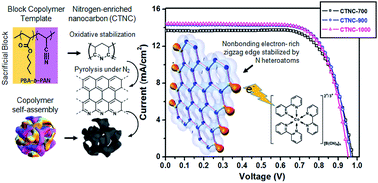Copolymer-templated nitrogen-enriched nanocarbons as a low charge-transfer resistance and highly stable alternative to platinum cathodes in dye-sensitized solar cells†
Abstract
In this report, we demonstrate the superior performance of dye-sensitized solar cells (DSSCs) with novel, metal-free counter electrodes (CEs) comprised of copolymer-templated nitrogen-enriched nanocarbons (CTNCs) with well-controlled morphology, nanoporosity, and nitrogen content. This superior performance is due to the high catalytic activity of CTNCs toward the reduction of Co(bpy)32+/3+, as evidenced by unusually low charge transfer resistance (RCT) at the CE–electrolyte interface. The observed activity is attributed to the combination of the high surface area of CTNCs afforded by a three-dimensional, hierarchical pore structure, and to their unique electronic properties stemming from the presence of nitrogen heteroatoms located on the edges of nanographitic domains. Altogether, the use of CTNC CEs enhanced the efficiency and fill factor (FF) of JK-306 dye, Co(bpy)32+/3+ redox couple based DSSCs at one sun illumination up to 10.32% and 73.5%, respectively, suggesting the considerable promise of these materials as an attractive alternative to costly Pt-based CEs. Interestingly, the use of CTNCs did not lead to the analogous beneficial lowering of RCT in I−/I3− redox couple based N719-sensitized DSSCs, limiting their FF and short circuit current density (JSC). This chemical specificity indicates that the type of nitrogen bonding configurations, rather than the total N-content, is the key factor determining the catalytic activity.


 Please wait while we load your content...
Please wait while we load your content...